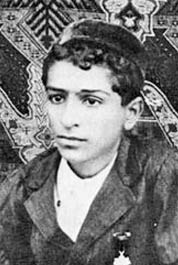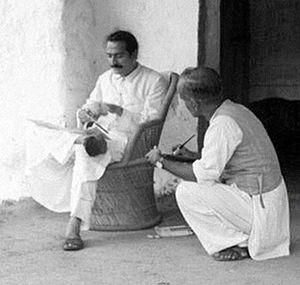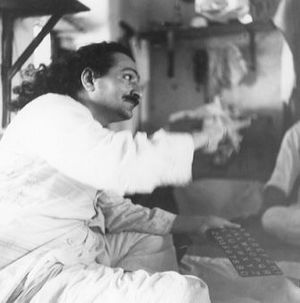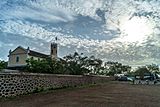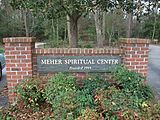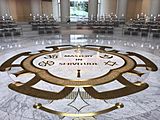Meher Baba facts for kids
Quick facts for kids
Meher Baba
|
|
|---|---|
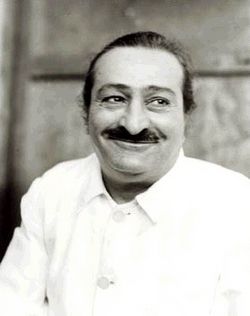
Meher Baba in 1945
|
|
| Born |
Merwan Sheriar Irani
25 February 1894 |
| Died | 31 January 1969 (aged 74) |
| Other names | The Awakener |
|
Notable work
|
God Speaks, Discourses |
|
Main interests
|
Religion, metaphysics, aesthetics, ethics |
|
Influences
|
|
| Signature | |
 |
|
Meher Baba (born Merwan Sheriar Irani; 25 February 1894 – 31 January 1969) was an Indian spiritual master who said he was the Avatar, or God in human form, of the age. A major spiritual figure of the 20th century, he had a following of hundreds of thousands of people, mostly in India, but with a significant number in the United States, Europe and Australia.
Meher Baba's map of consciousness has been described as "a unique amalgam of Sufi, Vedic, and Yogic terminology". He taught that the goal of all beings was to gain consciousness of their own divinity, and to realise the absolute oneness of God.
At the age of 19, Meher Baba began a seven-year period of spiritual transformation, during which he had encounters with Hazrat Babajan, Upasni Maharaj, Sai Baba of Shirdi, Tajuddin Baba, and Narayan Maharaj. In 1925, he began a 44-year period of observed silence, during which he communicated first using an alphabet board, and by 1954, entirely through hand gestures using an interpreter. He died in 1969, and was buried in Meherabad. His tomb has become a place of pilgrimage for his followers, often known as "Baba lovers".
Contents
Overview of teachings
Meher Baba's teachings concerned the nature and purpose of life. He described the phenomenal world as illusory, and presented the idea that the Universe is imagination. He taught that God alone exists, and each soul is God passing through imagination in order to realize its own divinity. He presented advice to followers wishing to attain God-realization, and thereby escape the wheel of birth and death. His other teachings included discussion of Perfect Masters, the Avatar, and those on the various stages of the spiritual path which he termed involution. The works by him regarded as most important were his books God Speaks and Discourses.
For decades, he declined to speak, and, later, also refrained from communicating via written language. This practice of abstinence has remained a topic of discussion among some of his followers.
Wider influence
His legacy includes the Avatar Meher Baba Charitable Trust he established in India, a handful of centers for information and pilgrimage. He has had influence on pop culture creators and introduced the common phrase "Don't worry; be happy". This was used in Bobby McFerrin's hit 1988 song of the same name. Among his followers were well-known musicians like Melanie Safka and Pete Townshend, as well as journalists like Sir Tom Hopkinson.
In 1971, Baba's following in the United States was estimated at 7,000. However, other commentators have suggested that the size of the movement has been underestimated because public proselytising is uncommon among Baba's followers, and that in 1975, the movement was larger than the more visible Hare Krishna movement. He was a self-identified Sufi, and considered a leader of the Californian branch of Western Sufism, though his version of Sufism shared very few similarities with the Sufi Movement, apart from universalism and anti-dogmatism.
Regardless, Baba's Sufi influence is said to have drawn from Sai Baba of Shirdi, and it was he who designated Sai Baba with the specifically Sufi status of Qutb.
Life and works
Early life
Baba was born to Irani Zoroastrian parents in 1894 in Pune, India. He was named Merwan Sheriar Irani, the second son of Sheriar Irani and Shireen Irani. Sheriar Irani was a Persian Zoroastrian from Khorramshahr who had spent years wandering in search of spiritual experience before settling in Poona (today known as Pune).
As a boy, Baba formed the Cosmopolitan Club, which was dedicated to remaining informed on world affairs and donating money to charity. He was a multi-instrumentalist and poet. Fluent in several languages, he was especially fond of the poetry of Hafez, William Shakespeare, and Percy Bysshe Shelley.
His spiritual transformation began when he was 19 years old and lasted for seven years. At 19, he met Hazrat Babajan, an elderly Muslim saint. He was cycling past a tree that she had made her abode, when she called to him. When he approached her, she kissed him on the forehead, causing him to enter a nine month-long trance which he described as "divine bliss", with a lack of consciousness of his body. Babajan predicted that he would become a spiritual leader. He then encountered Upasni Maharaj, who he later said helped him to integrate his mystical experiences with ordinary consciousness, thus enabling him to function in the world without diminishing his experience of God-realization.
Over the next several years, he encountered other spiritual figures, namely Tajuddin Baba, Narayan Maharaj, and Sai Baba of Shirdi, who, along with Babajan and Upasni Maharaj, Baba later said were the five "Perfect Masters" of the age. By early 1922, at the age of 27, Baba began gathering his own disciples. They gave him the name Meher Baba, which meant "compassionate father".
In 1922, Meher Baba and his followers established Manzil-e-Meem (House of the Master) in Bombay (now called Mumbai). There, Baba commenced his practice of demanding strict discipline and obedience from his disciples. A year later, Baba and his mandali moved to an area a few miles outside Ahmednagar that he named Meherabad (Garden of Blessing). This ashram would become the center for his work. During the 1920s, Meher Baba opened a school, hospital, and dispensary at Meherabad, all three free and open to all castes and faiths.
From 10 July 1925 until the end of his life, Meher Baba maintained silence. With his mandali (circle of disciples), he spent long periods in seclusion, during which time he often fasted. He also traveled widely, held public gatherings, and engaged in works of charity with lepers and the poor. He now communicated first through chalk and slate, then by an alphabet board, and later via a repertoire of gestures unique to him. On 1 December 1926, he wrote his last message, and began relying on an alphabet board.
1930s – First contact with the West
Beginning in 1931, Meher Baba made the first of many visits to the West. Throughout that decade, Meher Baba began a period of extensive world travel and took several trips to Europe and the United States. It was during this period that he established contact with his first close group of Western disciples. He traveled on a Persian passport, as he had given up writing, as well as speaking, and would not sign the forms required by the British government of India. Here, he attracted more followers. Throughout most of the 1940s, Meher Baba worked with a category of spiritual aspirants called masts, who he said are entranced or spellbound by internal spiritual experiences. Starting in 1949, along with selected mandali, he traveled incognito about India in an enigmatic and still largely unexplained period he called the "New Life".
On his first trip to England in 1931, he traveled on the SS Rajputana, at the same time as Mahatma Gandhi, who was sailing to the second Round Table Conference in London. Baba and Gandhi met thrice on board. One of these exchanges lasted for three hours. The British press publicized these meetings, but an aide to Gandhi said, "You may say emphatically that Gandhi never asked Meher Baba for help or for spiritual or other advice."
In the West, Meher Baba met with a number of celebrities and artists, amongst them Gary Cooper, Charles Laughton, Tallulah Bankhead, Boris Karloff, Tom Mix, Maurice Chevalier, and Ernst Lubitsch. On 1 June 1932, Mary Pickford and Douglas Fairbanks, Jr. held a reception for Baba at Pickfair at which he delivered a message to Hollywood. As a result, says Robert S. Ellwood, Meher Baba emerged as "one of the enthusiasms of the '30s".
In 1934, after announcing that he would break his self-imposed silence in the Hollywood Bowl, Baba changed his plans abruptly, boarded the RMS Empress of Canada, and sailed to Hong Kong without explanation. The Associated Press reported that "Baba had decided to postpone the word-fast-breaking until next February because 'conditions are not yet ripe'." He returned to England in 1936 but did not return to the United States again until the early 1950s.
In the late 1930s, Meher Baba invited a group of Western women to join him in India, where he arranged a series of trips throughout India and British Ceylon that became known as the Blue Bus Tours. When the tour returned home, many newspapers treated their journey as an occasion for scandal. Time Magazine's 1936 review of God is my Adventure describes the US's fascination with the "long-haired, silky-mustached Parsee named Shri Sadgaru [sic] Meher Baba" four years earlier.
1940s – Masts and the New Life
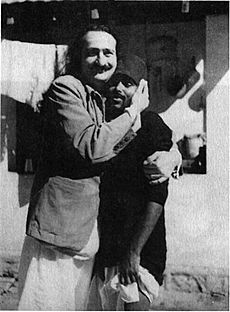
In the 1930s and 1940s, Meher Baba worked extensively with masts. According to Baba, these individuals are disabled by their enchanting experience of the higher spiritual planes. Although outwardly masts may appear irrational or insane, Baba claimed that their spiritual status was elevated, and that by meeting with them he helped them to move forward spiritually while enlisting their aid in his spiritual work. One of the best known of these masts, known as Mohammed Mast, lived at Meher Baba's encampment at Meherabad until his death in 2003.
During his journey in 1946, he went to Sehwan Sharif to meet a well known sufi saint and a successor of Lal Shahbaz Qalandar, Murshid Nadir Ali Shah, whom Baba called an advanced pilgrim.
In 1949 Baba began an enigmatic period that he called the New Life. Following a series of questions on their readiness to obey even the most difficult of his requests, Baba selected 20 companions to join him in a life of complete "hopelessness and helplessness".
He made provisions for those dependent on him, after which he and his companions otherwise gave up nearly all property and financial responsibilities. They traveled about India incognito while begging for food and carrying out Baba's instructions in accordance with a strict set of "conditions of the New Life". These included absolute acceptance of any circumstance and consistent good cheer in the face of any difficulty. Companions who failed to comply were sent away.
Meher Baba ended the New Life in February 1952 and once again began a round of public appearances throughout India and the West.
1950s – God Speaks and automobile accidents
After being injured as a passenger in two serious automobile accidents, one near Prague, Oklahoma in the United States in 1952 and one in India in 1956, Meher Baba's ability to walk became limited.
In the 1950s, Baba established two centers outside of India, namely the Meher Spiritual Center in Myrtle Beach, South Carolina in the United States and Avatar's Abode near Brisbane, Australia. He inaugurated the Meher Spiritual Center in April 1952. On 24 May 1952, en route from the Spiritual Center to Meher Mount in Ojai, California, the car in which he was a passenger was struck head-on near Prague, Oklahoma. He and his companions were thrown from the vehicle and suffered many injuries. Baba's leg was severely broken and he sustained facial injuries including a broken nose. The injured were treated at Duke Hospital in Durham, North Carolina, after which they returned to Myrtle Beach to recuperate. While recuperating at Youpon Dunes, a home owned by Elizabeth Patterson, in Myrtle Beach, he worked on the charter for a group of Sufis, which he named Sufism Reoriented.
Meher Baba began dictating his major book, God Speaks, The Theme of Creation and Its Purpose, using an alphabet board in Dehradun, August 1953. In September 1954, Meher Baba gave a men-only sahavas at Meherabad that later became known as the Three Incredible Weeks. During this time Baba issued a declaration, "Meher Baba's Call", wherein he once again affirmed his Avatarhood "irrespective of the doubts and convictions" of others. At the end of this sahavas, Meher Baba gave the completed manuscript of his book God Speaks to two members of Sufism Reoriented, Ludwig H. Dimpfl and Don E. Stevens, for editing and publication in America. The book was subsequently published by Dodd, Mead and Company the following year.
On 30 September 1954 Meher Baba gave his Final Declaration message, in which he made enigmatic predictions.
In October 1954, Meher Baba discarded his alphabet board and began using a unique set of hand gestures to communicate, which he used for the remainder of his life.
On 2 December 1956, outside Satara, India, the car in which Baba was being driven went out of control and a second serious automobile accident occurred. Baba suffered a fractured pelvis and other severe injuries. This collision seriously incapacitated Baba. Despite his physicians' predictions to the contrary, Baba began to walk again after great effort, but from that point on he was in constant pain and was severely limited in his ability to move. During his trip to the West in 1958, he often needed to be carried from venue to venue.
In 1956, during his fifth visit to the US, Baba stayed at New York's Hotel Delmonico before traveling to the Meher Center at Myrtle Beach, South Carolina. In July he traveled to Washington, D.C., and received friends and disciples at the home of Ivy Duce, wife of James Terry Duce, the vice-president of the Arabian American Oil Co. He then traveled to Meher Mount at Ojai, California before continuing on to Australia. His final visits to the United States and Australia were made in 1958.
Death and aftermath
On 31 January 1969, Meher Baba died at his home in Meherabad, 25 days short of his 75th birthday. He conveyed by his last gestures, "Do not forget that I am God." In time, his devotees called the anniversary of his death Amartithi (deathless day). Meher Baba's body was placed at his samadhi at Meherabad, covered with roses and cooled by ice. His body was kept available to the public for one week before its final burial. Prior to his death, Meher Baba had made extensive preparations for a public darshan program to be held in Poona. His mandali decided to proceed with the arrangements despite the absence of the host. Several thousand attended this "Last Darshan," including many hundreds from the United States, Europe, and Australia.
Silence
From 10 July 1925, until his death in 1969, Meher Baba was silent. He communicated first by using an alphabet board and later by unique hand gestures which were interpreted and spoken out by one of his mandali, usually by his disciple Eruch Jessawala. Meher Baba said that his silence was not undertaken as a spiritual exercise but solely in connection with his universal work.
Meher Baba often signaled the moment "that he would 'break' his silence by speaking the 'Word' in every heart, thereby giving a spiritual push forward to all living things".
According to him, the breaking of his silence would be a defining event in the spiritual evolution of the world.
On many occasions Meher Baba promised to break his silence with an audible word before he died, often stating a specific time and place when this would occur, but according to all contemporary accounts, Meher Baba remained silent until his death. His failure to break his silence disappointed some of his followers, while others regarded these broken promises as a test of their faith. A number of his followers speculate that "the Word" will yet be "spoken" or that Meher Baba broke his silence in a spiritual rather than a physical way.
Baba, for many years, asked his followers to undertake austerities on 10 July, the anniversary of the day his silence began, such as keeping silence, fasting, and praying. In his final Silence Day request to his followers in 1968, he asked only that they keep silent. Many followers continue to celebrate Silence Day by keeping silence in his honor.
Teachings
Meher Baba's teachings can roughly be divided into two main categories: his metaphysics on the nature of the soul and the Universe, and practical advice for the spiritual aspirant. The two are interrelated. His metaphysics is mostly found in his principal book on the subject, God Speaks. It contains detailed statements on his cosmology and the purpose of life as well as the progression of the soul, while his elucidations on the practical spiritual life are mostly contained in Discourses, although it also covers many metaphysical areas mirroring or amplifying God Speaks.
God Speaks
In God Speaks, Meher Baba describes the journey of the soul from its original state of unconscious divinity to the ultimate attainment of conscious divinity. The whole journey is a journey of imagination, where the original indivisible state of God imagines becoming countless individualized souls which he likens to bubbles within an ocean of infinite size. Each soul, powered by the desire to become conscious, starts its journey in the most rudimentary form of consciousness. This limitation brings the need of a more developed form to advance it towards an increasingly conscious state. Consciousness grows in relation to the impressions each form is capable of gathering.
According to Baba, each soul pursues conscious divinity by evolving, that is, experiencing itself in a succession of imagined forms through seven "kingdoms" of stone/metal, vegetable, worm, fish, bird, animal, and human. The soul identifies itself with each successive form, becoming thus tied to illusion. During this evolution of forms, the power of thought increases, until in human form thought becomes infinite. Although in human form, the soul is capable of conscious divinity, all the impressions that it has gathered during evolution are illusory ones that create a barrier against the soul knowing itself. For this barrier to be overcome, further births in human form are needed in a process known as reincarnation.
The soul will reach a stage where its previously gathered impressions grow thin or weak enough that it enters a final stage called involution. This stage also requires a series of human births, during which the soul begins an inner journey, by which it realizes its true identity as God. Baba breaks this inner journey of Realization into seven stages he called "planes." The process culminates, at the seventh plane, with God-realization, at which the goal of life for the soul is reached.
Discourses
The Discourses are a collection of explanations and elucidations that Meher Baba has given on many topics that concern the advancement of the spiritual aspirant. Some of the most important topics treated are: sanskaras (mental impressions), Maya (the principle of illusion), the nature of the ego, reincarnation, karma, violence and non-violence, meditation, love, discipleship, and God-realization. His explanations often include stories from the lore of India and the Sufi culture. One such story, the wise man and the ghost, shows the power that superstitious beliefs can have on a person, while another, Majnun and Layla, show how selfless love, even in human relations, can lead one to discipleship.
Thus Meher Baba offers many suggestions that keep one moving towards God-realization. These suggestions include putting theory into practice, the internal renunciation of desires, offering selfless service to humanity or the master, spontaneity, while avoiding actions that bind one to illusion. But rather than lay out moral rules, Baba offers an understanding as to why some actions bind the individual whereas some others help towards his emancipation. Many chapters offer a better understanding of the mechanisms by which consciousness gets caught up between the opposites of experience, such as pleasure and pain, good and evil, and point to a way of transcending them.
Perfect Masters and the Avatar
Baba related that there are 56 incarnate God-realized souls on Earth at any given time. Of these souls there are always five who constitute the five Perfect Masters of their era. When one of the five Perfect Masters dies, according to Baba, another God-realized soul among the 56 would replace him or her at once.
The Avatar, according to Baba, is a special Perfect Master, the first soul to achieve God-realization. This soul, the original Perfect Master, or Ancient One, never ceases to incarnate. Baba indicated that this particular soul personifies the state of God called Vishnu in Hinduism and Parvardigar in Sufism, i.e. the sustainer or preserver state of God. The Avatar, in Baba's testimony, appears on Earth every 700–1400 years and is "brought down" into human form by the five Perfect Masters of the time to aid in the process of moving creation in its never-ending journey toward Godhood. Baba claimed that in other ages this role had been fulfilled by Zoroaster, Rama, Krishna, Buddha, Jesus, and Muhammad.
Baba described the Avatar as "a gauge against which man can measure what he is and what he may become. He trues the standard of human values by interpreting them in terms of divinely human life."
The majority of Meher Baba's followers accept his claim of avatarhood, and he is said to be "revered by millions around the world as the Avatar of the age and a God-realized being".
Legacy
Baba's travels and teachings left a legacy of followers and devotees worldwide.
The Avatar Meher Baba Charitable Trust, established by Meher Baba in 1959, maintains his tomb and pilgrimage facilities, as well as a free school and dispensary, a cataract clinic, and a veterinary clinic. The Trust follows the charter left for it by Meher Baba in his lifetime, but does not act as spiritual authority over groups. Likewise, the Trust does not engage in propaganda, promote creeds or dogmas, or seek converts. Baba discouraged evangelizing, stating, "I need no propaganda or publicity." Rather, he encouraged his followers to "let your life itself be my message of love and truth to others" and to "spread my message of Love and Truth as far and wide as possible". Followers of Meher Baba have no established rituals. Many do, however, perform practices of choice such as pujas, aartis, prayers, music, plays, viewing films of Baba and so forth, but the choice is personal. The primary focus for followers is living a life Meher Baba would approve of.
Gatherings of Baba followers are generally informal. Special effort is made to gather together on Amartithi, the anniversary of Baba's death, and on his birthday. Many Baba followers keep silent on 10 July (Silence Day), observing the request Baba frequently made of his followers during his lifetime. Aarti is performed morning and evening at Baba's samadhi in India. Also at Meherabad, his followers maintain Baba's practice of lighting a dhuni fire on the 12th of each month.
Baba had gained public attention in the West as early as 1932, as the result of contacts with contemporary celebrities of the time, and from the rather disillusioned account of Paul Brunton in his A Search in Secret India (1934). Baba received further attention posthumously via various mentions in western pop-culture.
Pete Townshend of the Who, became a follower of Baba, and dedicated his 1969 rock opera Tommy to him in the gatefold. The Who's 1971 song "Baba O'Riley" was named in part after Meher Baba, and Townshend recorded several Meher Baba tribute albums including Happy Birthday, I Am, Who Came First, and With Love.
In 1970, Melanie Safka (stage name "Melanie") mentioned Baba in the spoken word intro to her song "Lay Down (Candles in the Rain)". Listed as a standalone piece entitled "Candles In The Rain", the lyrics are "Meher Baba lives again".
Bobby McFerrin's 1988 Grammy Award-winning song "Don't Worry, Be Happy" was inspired by Baba's adage, which has appeared on many posters and inspirational cards depicting him.
Elements of Meher Baba's philosophy, as well as an unnamed character based upon him, have appeared in the works of comic book writer-screenwriter J. M. DeMatteis. Works particularly influenced by Baba include DeMatteis' scripts for Doctor Fate and DeMatteis creator-owned comic book Seekers into the Mystery.
In 2012, the feature film Nema Aviona za Zagreb premiered in the Netherlands with an exclusive interview with Meher Baba filmed in 1967.
Major Centers of Pilgrimage
-
Upper Meherabad, near Ahmednagar, India
-
Meher Baba's House in Pune, India
-
Universal Spiritual Center in Byramangala, Karnataka, India
-
Meher Baba's Manonash Cave in Khajaguda, Hyderabad, India
-
Meher Spiritual Center Entrance in Myrtle Beach, South Carolina, USA
-
Meher Baba Heartland center in Prague, Oklahoma, USA
-
Meher Mount Center in Sulphur Mountain, Ojai, California, USA
-
Sufism Reoriented Sanctuary in Walnut Creek, California, USA
-
The Avatar's Abode in Kiels Mountain, Queensland, Australia
See also
 In Spanish: Meher Baba para niños
In Spanish: Meher Baba para niños


